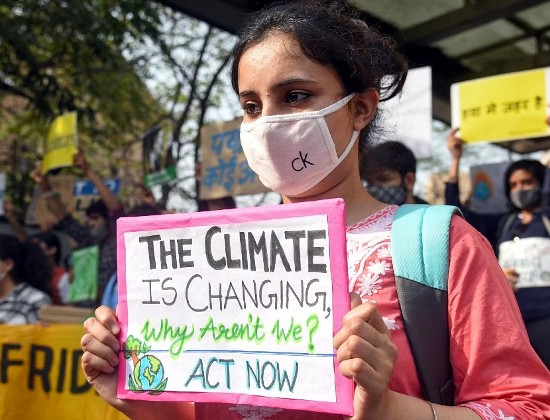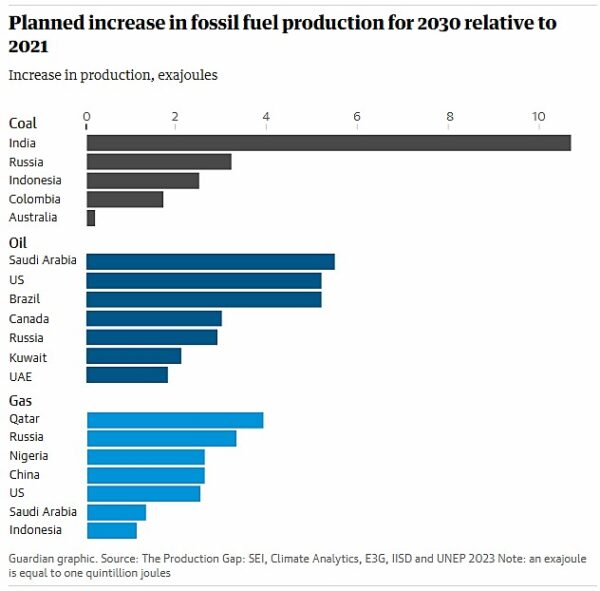
There is no petrostate on Earth, or for that matter, fossil fuel company, planning to lower the planet’s temperature by writing and filling a prescription to reduce the production of their assets directly linked to atmospheric warming. It is as if the tobacco companies have been put in charge of lung health policy for the planet knowing full well that smoking causes cancer and heart disease.
We are not just talking about natural gas and oil. Even plans for coal production show no regard for the consequences of adding more carbon dioxide (CO2), methane (CH4) and other greenhouse gas (GHG) emissions to an already overheating world. How much will the latent impact of GHGs currently being added to the atmosphere increase air temperatures? The median lag time for CO2 emissions to produce maximum warming is around 10 years, whereas CH4 causes an immediate spike with its impact degrading after 12 years.
The United Nations Emissions Gap Report issued this month states that the goals set by the Paris Climate Agreement in 2015 are far removed from where the planet is heading. Before that agreement, GHG emission forecasts predicted a 16% rise by 2030 if nothing changed. Then the world’s nations signed on to act and report reduction strategies. Well, the results since their 2015 pledge have seen GHGs continue to rise with the forecast for 2030 to be 3% higher. Latent heat will continue to play its part. The delayed cause and effect will continue to raise temperatures even as we reduce GHGs rather than add to them which appears to be what’s in store for us from actions by petrostates and fossil fuel companies.
So forget the targets set at Paris in 2015 which called for a 28% drop in GHGs to keep temperatures from rising to 2 Celsius (3.6 Fahrenheit), and 42% to keep the mean global rise to 1.5 Celsius (2.7 Fahrenheit).
In August, NASA issued a climate risk assessment that described what the world would be like at 2 Celsius warmer. It noted that the 2-degree threshold would lead to “dangerous and cascading effects.” What would be the results?
- Most of the world would experience higher heat stress with more than 25% of the global population suffering from an additional month of severe heat when compared to conditions at the mid-20th century point.
- High temperatures and drought could combine in places like the Amazon River Basin to increase wildfire risk and further deforestation.
- The American West would experience extreme fire weather more intense than what has been recently seen. Fire weather would last longer than it does today.
One of the authors of the NASA report, Ramakrishna Nemani, a Senior Scientist with the Bay Area Environmental Research Institute in California stated, “The escalating impacts of all the climate extremes studied could cause significant damage to communities and economies, from fires, floods, landslides, and crop failures that may result.”
What Nemani doesn’t mention in this quote is other global impacts such as:
- Rising heat-related deaths.
- Increasing population displacement fueled by climate.
- The spread of tropical diseases into more temperate climate zones.
- Ocean acidification and sea level rise
- Changes to alpine glaciers in such places as the Himalayas, Andes, Alps and Rocky Mountains which would affect downstream rivers (The Himalayas provide much of the source water for China and the Indian subcontinent, the two most populous areas of the planet).
- The collapse of marine and land ecosystems.
The Plans of Fossil Fuel Producers
But fossil fuel producers believe in having their cake and eating it too with no worries. In the face of rising global temperatures, they are heading into 2030 and beyond with plans that include:
- a 460% increase in coal production.
- an 83% increase in natural gas production.
- a 29% increase in oil production.the atmosphere
The chart that follows provides greater production details by country for the three fossil fuel categories as measured in exajoules. An exajoule, if you don’t know, is equal to the energy produced by 174 million barrels of oil or its equivalents in coal or natural gas.
 The countries that are home to these energy producers intend to keep fossil fuels burning for as long as possible, ensuring profits will keep flowing into national coffers and shareholders’ pockets.
The countries that are home to these energy producers intend to keep fossil fuels burning for as long as possible, ensuring profits will keep flowing into national coffers and shareholders’ pockets.
A recent quote from Inger Andersen, Executive Director at the United Nations Environmental Programme, describes the current strategy as one that will “throw humanity’s future into question.” António Guterres, Secretary-General of the United Nations, has his thoughts about the disregard shown by fossil fuel-producing nations stating: “Governments are literally doubling down on fossil fuel production. That spells double trouble for people and planet. Fossil fuels are sending essential climate goals up in smoke.”
The fossil fuel industry professes it has the answer to quiet concerns raised by climatologists about putting more GHGs into the atmosphere. It is carbon capture and storage. The green pages of industry and petrostate websites describe investments and development of projects similar to The Pathways Alliance here in Canada.
I have a problem with these “pie-in-the-sky” promises. Take, for example, The Pathways Alliance which has put in only a small amount of seed money for planning what it is selling to the public: carbon capture at oil sands production sites, and a CO2 pipeline to carry the GHG to sites for underground permanent sequestration. The Alliance needs to spend tens of billions of dollars to make this “pipedream” a reality and is holding out a hand to governments to pick up much of the tab.
There is nothing new about these types of promised projects. The same strategy has been used before on carbon capture projects in Canada that have been abandoned by fossil fuel companies over the past two decades leaving government partners to deal with the debt.
Finally, the ultimate irony. This year global climate meeting is being held in Dubai, United Arab Emirates (UAE). The host city and country for COP28 to address climate change is a petrostate. Take a look at the graph above. Is the UAE planning to reduce oil production? No like all the other countries and fossil fuel companies the plans are to increase oil production between now and 2030. Does this sound insane to you, because it sure does to me.








